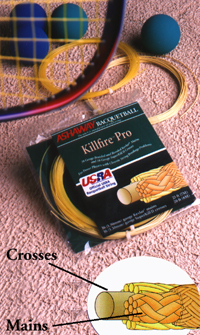|
|

Hybrid Stringing: The What and Why
By Steve Crandall
Vice President, Sales & Marketing
Ashaway Racket Strings
 One of the most frequent questions I get from racquetball players concerns hybrid stringing. This is an important concept, and one that is widely misunderstood. As a matter of fact, in our early returns on the pop quiz I gave in the last column, many respondents missed on the question about hybrid stringing. I'll review answers to the quiz when I've finished grading them, but in the meantime, let's get started on a series of columns I've put together to take the mystery out of hybrid stringing.
One of the most frequent questions I get from racquetball players concerns hybrid stringing. This is an important concept, and one that is widely misunderstood. As a matter of fact, in our early returns on the pop quiz I gave in the last column, many respondents missed on the question about hybrid stringing. I'll review answers to the quiz when I've finished grading them, but in the meantime, let's get started on a series of columns I've put together to take the mystery out of hybrid stringing.
About 25 years ago the concept of hybrid stringing, like many other things in our sport, was born across the border in the land of tennis. It was about that time that the first oversized tennis racquets were introduced to the market. Almost immediately this led to a number of issues regarding stringing.
About five years after that, the size and shape of racquetball racquets also began to change. Similar issues arose. In both sports, players looked to alternative stringing approaches to optimize new racquet geometries and get the most out of their preferred styles of play. Here's how the issues played out first in tennis.
Tension
At the same time that oversized tennis racquets were introduced, a young Swedish tennis player was winning many Grand Slam tournaments with his standard-sized racquet strung at 80 lbs. of tension, which provided for optimum topspin and control of the ball. Since oversized racquets had more string area, they also had to be strung at even higher tensions to duplicate the tension and feel of a standard-sized racquet. This led to the development of alternative stringing techniques, one of which was hybrid stringing.
Durability
While they helped players improve their game, oversized racquets also had an unwanted consequence-premature string wear and breakage. Due to the increased surface area, oversized racquets use more string and the string pattern is generally more open. This results in greater string movement during play and more friction between strings. With the evolving "topspin" game, increased tension and string movement, higher caliber players discovered their strings were snapping with disconcerting frequency. The practice of hybrid stringing was adapted to improve the durability and useful life of racquet string.
Trampoline Effect
One of the big initial drawbacks to oversized racquets resulted from what has become known as the "trampoline effect." Imagine you are bouncing happily on a relatively small and firm trampoline. Now imagine that the frame has increased in size to double the surface area of the trampoline with a corresponding decrease to its firmness. How sure-footed do you feel now?
Your loss of control on the trampoline is analogous to the loss of ball control players experience when racquet surface area is increased without using a compensating method of stringing. So hybrid stringing was one of the techniques developed to provide a firmer string bed and increased ball control-a good alternative to stringing frames at ridiculously high tensions.
So What Is It?
Preliminary results of the Pop Quiz show that there is a great deal of confusion between "hybrid stringing," "composite strings" and "hybrid tensioning." Each of these concepts produces different results. "Hybrid stringing" involves using two distinctly different types of string-one for the main strings and another for the crosses. Each type of string has a specific purpose and we'll discuss this in more detail in the next column.
Many respondents to the quiz thought that hybrid stringing referred to the use of a string constructed from two different types of raw material. A single string incorporating two different materials is a "composite string." A Composite string is taken from the same coil and used over the racquet's entire stringing area.
Other readers thought "hybrid stringing" involved using different tensions on the crosses and the mains. This common practice is "hybrid tensioning." It involves using the same coil of string, but placing different tensions on the racquet's crosses and mains.
While hybrid stringing became an important adjunct to the modern top spin game in tennis, many top-seated racquetball players have used hybrid stringing to take their game in an entirely different direction. We'll learn more about the evolution and theory of hybrid stringing in racquetball next time around.
This article previously appeared in Racquetball Magazine.
|